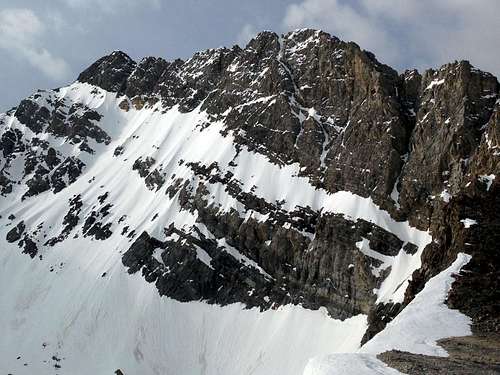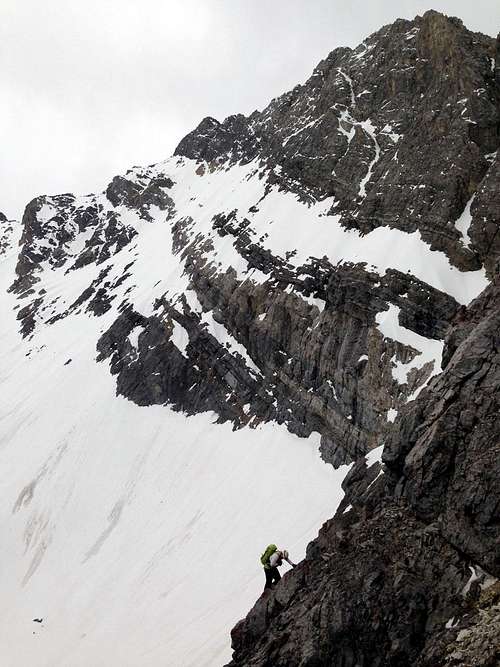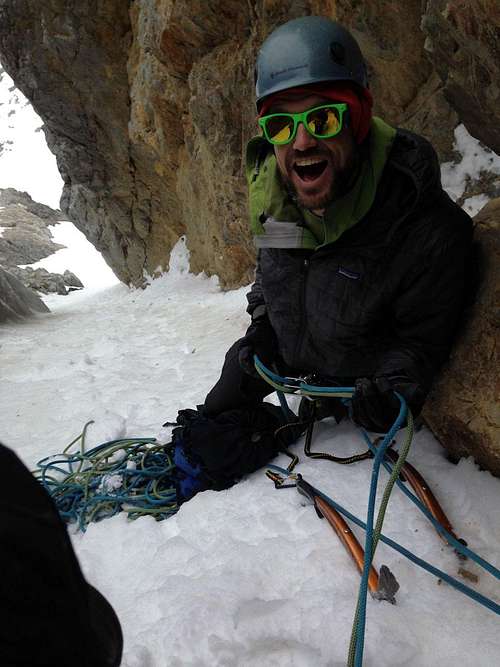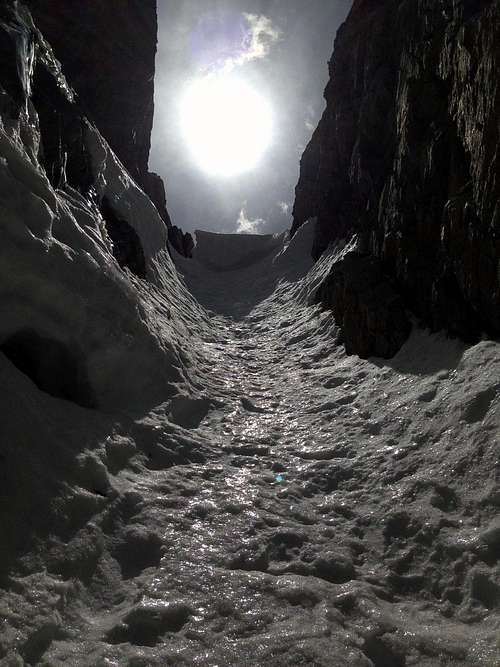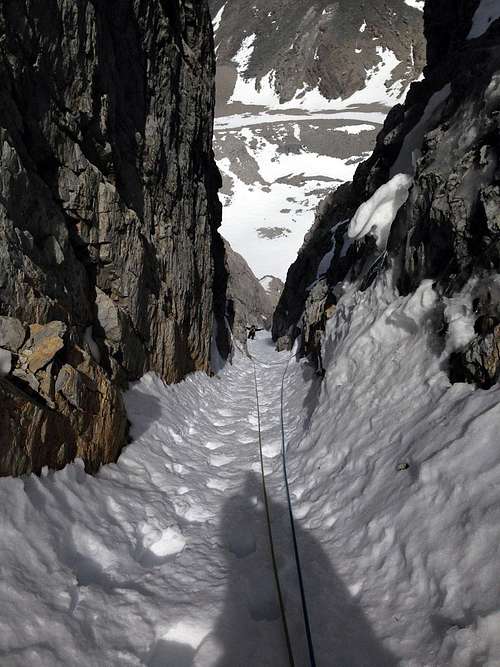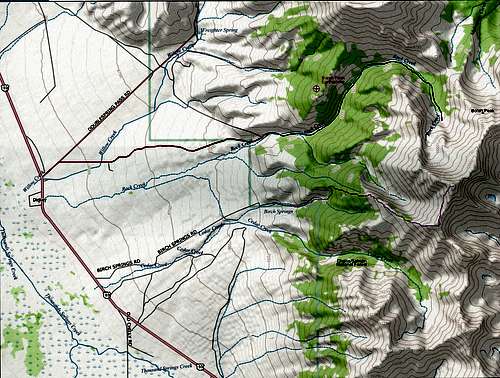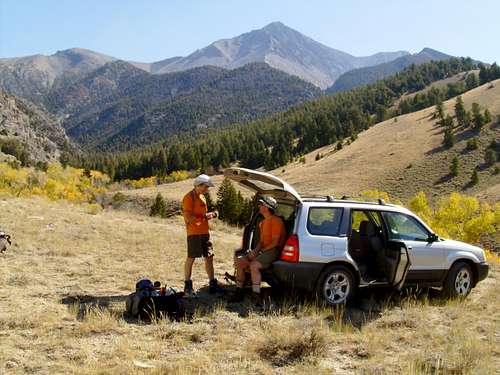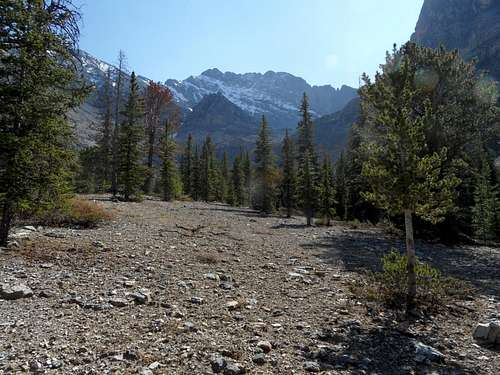Overview
Of all the routes that have been established in Mt Borah's North Face cirque, one has stood out as the test piece of alpine climbing in the range: Psycho Therapy. This route was first put up by Dean Lords and Bryan Woods in September 2003 (AAJ - Idaho 2004) and over the years resisted all attempts at a second ascent by some of Idaho's strongest alpine climbers until just this year, 2014. Both the first and second ascent teams described this route as being "run-out" and to quote Kevin, "hands down, the scariest lead of my life". As with most alpine climbs in the range, conditions play a big role in whether or not a route is in shape and rarely are they the same from season-to-season. In general, fall is considered the best time to find alpine ice climbing on the north face of Mt Borah, especially after a hard winter. However, some routes in the range are best attempted in late spring/early summer when there is still ample snow cover and (often) remaining winter ice. To date, all of the established alpine routes in this range have been done bottom-up, on-sight and without the use of bolts for protection.
![Psycho Therapy]() North Face of Mt Borah 6-1-2014 North Face of Mt Borah 6-1-2014 |
Route Description
Borah Peak, Psycho Therapy. On September 18, following the first major snow of the year, Brian Wood and I established Psycho Therapy (1,200', 5.9+ M6 AI4) on the north face of Borah Peak. This route follows the obvious couloir and black shaft of rock on the far right side of the face. The route starts with two pitches of alpine ice and a few mixed sections, before entering the shaft (a.k.a. Shock Treatment). The shaft is sustained for three pitches and involves steep climbing on icy runnels, snow-covered rock, and two large chockstones. After the second chockstone the angle eases and one and a half pitches of ice and rock in a wild setting finish in a steep notch on the northwest ridge. Brian and I spent 22 hours round trip from the mouth of Rock Creek. With more ice in the shaft, this route could be less difficult. Dean Lords
"Hands down the hardest and scariest climbing I've ever done in my life". Kevin Hansen 2014
2014 Trip Report by Cory Harelson: Psycho Therapy
![North Face Mt Borah]() Psycho Therapy Psycho Therapy |
![Psycho Therapy]() Psycho Therapy Psycho Therapy |
![Psycho Therapy]() Psycho Therapy Psycho Therapy |
![Psycho Therapy]() Psycho Therapy Psycho Therapy |
![Psycho Therapy]() Psycho Therapy Psycho Therapy |
Essential Gear
Gear to climb Psycho Therapy in May-June
A few gear placements present themselves in the sidewalls of the couloir. Typical of most rock climbing
in the Lost River Range, cam placements are very rare so camalots were not taken and never wished for.
5-8 bugaboo and knife blade pitons (yes, metal pins) Most placements are only good for 1-3 inches deep
2 sets of wire nuts. (most placements are finger width or smaller)
6 ice screws. (10 cm - 16 cm more 10's and 13's than 16's)
Gear for Psycho Therapy in October-November
More nuts,
1 set of 1-4 OP link cams,
Sticky rubber shoes, chalk, and change of clean underwear
Red Tape
None at all but it's a good idea to let someone know exactly where you are going.
Getting There
Mt Borah's north face cirque offers one of the easier approaches in the Lost River range both in driving and hiking time. The standard approach is from Rock Creek on the western side of the range (Highway 93). The turn-off to Rock Creek is a short distance up the Double Spring road about a mile north of the standard Mt Borah trail head turn-off.
Here's my suggestion for the easiest hike in to the face when Rock Creek is low enough to cross without difficulty. The road to Rock Creek is well described so I'll start at the upper parking spot above the small diversion dam. Park where the road makes a sharp bend and starts climbing a very steep hill (this is a hill that you do not want to drive). You will be on the left side of Rock Creek at this point. From here, folks tend to drop down to the dam and muck around in the Aspen looking for the creek crossing and trail. Instead, follow the contour (game trail) a short distance along the bare south-facing side of the canyon until you meet Rock Creek. Cross Rock Creek and then stay on the right side of the creek following a light boot trail up the canyon. A short ways up you will cross the debris from the west face drainage. The boot trail disappears from time-to-time in the scree and on the benches but if you keep your eyes open it is fairly easy to follow. The old (and much rumored) single track road that used to run up the canyon has either eroded away or is now covered with mature trees so don't bother looking for it. When the right side of the canyon starts to steepen, cross Rock Creek and stay on the left side of the canyon until it's obvious that you can go back to the right side of the canyon. The trail traverses the fairly steep (right) side of the canyon and soon climbs to more open ground where you will get a spectacular view of the mountain. Keep your ear on Rock Creek because around the three-mile mark it disappears underground and you may not see water again until you get to the cliff band at 9800'. Be aware that during the dry season or when the face is frozen up this may be the last place to find running water. If this sounds confusing, I'll break it down. Here's where you want to be: (mileage is approximate, total mileage to bottom of NF = +-5 miles) Left side of canyon - .25 mi Right side of canyon - 1.75 mi Left side of canyon - .25 mi Right side of canyon - .75 mi
At this point you should be close to where Rock Creek goes underground and the huge cirque above becomes visible. Climb another mile or so through the trees or follow the dry bottom of Rock Creek to the cliff band that blocks access to the moraine above. If dry, the
cliff band can be climbed by way of the
secret passage - the narrow Class 2 gully on the left or on the 3rd class+ steps just to the right of the gully. Directly above the cliff band there is a great biv site (when dry). It includes a big rectangular rock with a number of good boulder problems. Drinking water may not be available at this site during certain times of the year. When it's wet, it's best to avoid the drainages altogether, they are delicate and can flood very rapidly on this side of the mountain.
If this approach sounds too confusing then just stay on the right side of Rock Creek for the entire approach by climbing the ascending benches up the canyon. It is a steeper climb, holds snow later and leads to cliffs if you stray too high or low. It is also possible to drop directly into the cirque from the left spur on the Northwest Ridge but this involves some 4th and low 5th class climbing. If you're feeling adventurous you can take the short-cut over the Northwest ridge by using the
Mike Howard Traverse.
External Links
is the only recreational site in Challis that offers full RV hookups and
features a diversity of other facilities.


